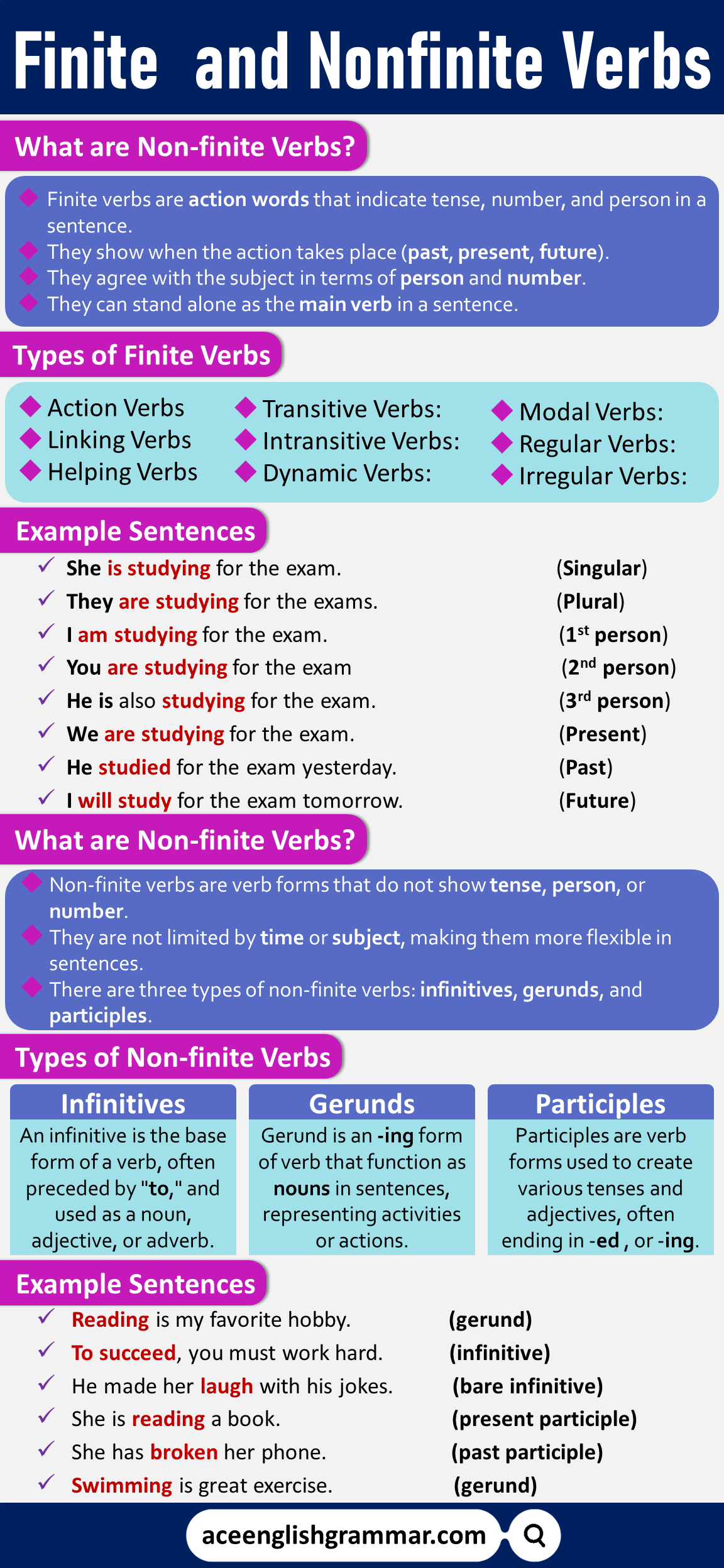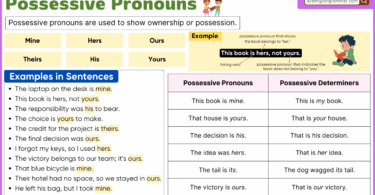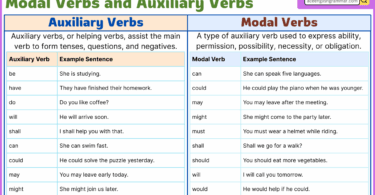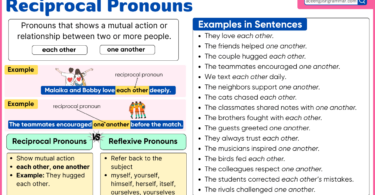Verbs are an essential part of a sentence that expresses actions or states of being in a sentence. Have you ever wondered why some verbs change based on the tense or the subject, while others remain the same? This is because verbs are classified into two main categories; Finite and Non-finite verbs. Finite verbs are those that change their form to indicate agreement with tense, mood, and subject, while nonfinite verbs remain the same regardless of the tense or the subject. Understanding the distinctions between these verb types is essential for clear and effective communication. In this article, we’ll explain what finite and nonfinite verbs are, and how they are used in a sentence with examples. So, let’s get started!
Table of Contents
What are Finite Verbs?
A finite verb is the main verb in a sentence that changes its form when we change the number, (singular, plural) person, (first second, third), or tense (past, present, future) of a sentence. It changes depending on who is doing the action and when it happened and indicates that the action is complete or finished. In contrast to a non-finite verb (such as infinitives and gerunds), a finite verb can serve as the main verb of a sentence and convey a complete idea on its own. Finite verbs are essential for constructing grammatically correct and meaningful sentences in various tenses, moods, and voices. For instance,
- She is studying for the exam.
Here “is studying” is the finite verb. “Is” is the present tense form of the verb “to be,” and “studying” is the present participle form of the verb “study.” Together, they indicate the ongoing action of studying that 3rd person singular) “She” is currently engaged in.
- I will call you later.
In this sentence “will call” is the finite verb. “Will” indicates future tense, and “call” is the base form of the verb. Together, they express the action of calling that the speaker (1st person singular) (“I“) intends to do in the future.
- We will visit the museum tomorrow.
In this sentence “will visit” is a finite verb expressing a future action. The verb “will” indicates the future tense, and it agrees with the plural subject “We.”
Characteristics of Finite Verbs:
Here are some basic characteristics of finite verbs:
Subject-Verb Agreement:
Finite verbs must agree with the subject of the sentence in terms of tense, number, and person. This agreement ensures that the verb matches the subject properly and prevents grammatical inconsistencies. For example, in the sentence “She plays cricket.” the verb “plays” agrees with the third-person singular subject “She.”
- He plays cricket. (Singular subject)
- They play football. (Plural subject)
Tense Indication:
Finite verbs indicate the time of the action or state of being. They can be in present, past, or future tense. For example:
- He reads comic books. (Present tense)
- She completed the assignment yesterday. (Past tense)
- We will travel to Paris next week. (Future tense)
Person Specification:
Finite verbs also indicate the person of the subject – whether it’s first person (I, we), second person (you), or third person (he, she, it, they). For example,
- I am excited about the trip. (First person)
- You have a beautiful voice. (Second person)
- She likes reading books. (Third person)
Ability to Stand Alone:
Finite verbs can function as the main predicate of a sentence on their own, conveying a complete thought. They can create meaningful sentences independently.
- Dogs bark.
- She swims.
Formation of Questions and Negatives:
Finite verbs play a crucial role in forming questions and negatives by undergoing specific changes in their forms.
- Did you enjoy the movie? (Question)
- I don’t like spicy food. (Negative)
Mood and Voice:
Finite verbs can also express different moods (indicative, imperative, subjunctive, and conditional) and voices (active and passive) to convey the attitude of the speaker or the relationship between the subject and the action.
- Close the door quietly. (imperative mood)
- If I were you, I would study (subjunctive)
- She would go with you if she could. (conditional mood)
- They built a new bridge. (active)
- A new bridge was built by them. (passive)
Types of finite verbs
The types of finite verbs include:
Action Verbs:
Definition:
- Action verbs express physical or mental actions. They depict what someone or something does.
Examples:
- She runs every morning.
- He reads books regularly.
- They built a sandcastle on the beach.
Linking Verbs:
Definition:
- Linking verbs connect the subject of a sentence to its complement, describing a state or condition.
Examples:
- She is happy.
- The flowers smell wonderful.
- The cake tastes delicious.
Helping Verbs (Auxiliary Verbs):
Definition:
- Helping verbs assist the main verb in forming verb phrases, conveying aspects of time and mood.
Examples:
- She has completed her homework.
- They will visit us tomorrow.
- I am writing a short story.
Modal Verbs:
Definition:
- Modal verbs express possibility, necessity, ability, or permission. They often accompany the base form of the main verb.
Examples:
- You can join us for dinner.
- She must finish her assignment.
- We should exercise regularly.
Transitive Verbs:
Definition:
- Transitive verbs require a direct object to complete their meaning. They transfer the action to something or someone.
Examples:
- She ate the cake.
- He painted a beautiful picture.
- They built a new house.
Intransitive Verbs:
Definition:
- Intransitive verbs do not require a direct object to make sense. They convey the action without transferring it to an object.
Examples:
- The bird sings melodiously.
- She laughs uncontrollably.
- He sleeps peacefully.
Regular and Irregular Verbs:
Definition:
- Regular verbs follow a predictable pattern when forming past tense by adding “-ed.” Irregular verbs, however, have unique past tense forms.
Examples:
- Regular: She walked to the store.
- Irregular: They ate dinner together.
- Regular: He played the guitar.
- Irregular: We sang our favorite songs.
Finite verbs Example sentences
- She is working on a new project.
- I will visit you tomorrow.
- We are planning a trip.
- He has already finished his lunch.
- The flowers smell delightful.
- The weather seems nice today.
- You can solve this puzzle.
- She bought a new dress.
- His idea sounds interesting.
- She writes beautiful poems..
- The dog barks loudly.
- They built a sandcastle on the beach.
- He painted a beautiful landscape.
- We watched an exciting movie.
- They have completed their assignment.

Finite and Non-finite Verbs
What are Non-finite Verbs?
Nonfinite verbs are verb forms that do not function as the main verb of a sentence. They are not affected by tense or subject agreement, as they are not used as the main verb in a sentence. Instead, they function as auxiliary verbs, helping to form phrases that convey additional information about the action being described. Non-finite verbs do not change their form even if we change the number, person, or tense of a sentence. They remain the same everywhere. They are often used as modifiers, nouns, adjectives, or adverbs within sentences. For example;
- I like to play basketball.
- They want to play basketball.
- He used to play basketball.
Here the numbers are changing (I and he singular, they plural) persons are changing (I 1st person, he and they 3rd person) tenses are also changing, But all these changes are not affecting the nonfinite verb (To play) because they are not bound by the subject or the time frame of the sentence. So, they remain the same everywhere.
Characteristics of Non-Finite Verbs:
Here are some basic characteristics of non-finite verbs:
- No Subject-Verb Agreement:
- Non-finite verbs do not change their form based on the subject of the sentence. They remain in their base form regardless of whether the subject is singular or plural.
- Example: To dance is fun. (No change in “dance” based on the subject.)
- Non-finite verbs do not change their form based on the subject of the sentence. They remain in their base form regardless of whether the subject is singular or plural.
- No Indication of Tense:
- Unlike finite verbs, non-finite verbs do not convey the specific time of the action. They lack the distinctions of past, present, or future tense.
- Example: She enjoys reading. (No indication of when she enjoys reading.)
- Unlike finite verbs, non-finite verbs do not convey the specific time of the action. They lack the distinctions of past, present, or future tense.
- Play Supporting Roles:
- Non-finite verbs often complement the main verb or provide additional information. They function as infinitives, gerunds, or participles and play supporting roles in a sentence.
- Example: He wants to sing a song. (The infinitive “to sing” supports the main verb “wants.”)
- Non-finite verbs often complement the main verb or provide additional information. They function as infinitives, gerunds, or participles and play supporting roles in a sentence.
- Can’t Stand Alone:
- Non-finite verbs are team players; they can’t stand alone and form complete thoughts. They need a finite verb to lead the sentence.
- Example: Running late, she missed the bus. (“Running” can’t stand alone as a complete thought.)
- Non-finite verbs are team players; they can’t stand alone and form complete thoughts. They need a finite verb to lead the sentence.
- Dependent on Finite Verbs:
- Non-finite verbs often rely on finite verbs to give a sentence its full meaning. They work together as a team to convey a complete idea.
- Example: She wants to travel the world. (“To travel” depends on the finite verb “wants” to express a complete idea.)
- Non-finite verbs often rely on finite verbs to give a sentence its full meaning. They work together as a team to convey a complete idea.
- Can Stand Alone in Certain Constructions:
- While non-finite verbs are typically part of a larger sentence, they can stand alone in specific constructions, such as commands or exclamations.
- Example: Run! (The non-finite verb “run” stands alone as a command.)
- While non-finite verbs are typically part of a larger sentence, they can stand alone in specific constructions, such as commands or exclamations.
Types of Non-finite Verbs:
There are three main types of nonfinite verbs: infinitives, gerunds, and participles.
Infinitives (to + base form)
Infinitives are the base forms of verbs preceded by the word “to. They can be used with or without “to” and when it is used without to it is called the bare infinitive. They often function as nouns, adjectives, or adverbs in a sentence. For example,
- She can speak (bare infinitive)
- She likes to dance. (noun)
- She is eager to learn. (adjective)
- He came here to help. (adverb)
Gerunds: (base form + ing)
The present participle (ing) form of a verb that functions as a noun in a sentence is called a gerund. Gerund shows activity in a sentence. They don’t perform any action in a sentence. They can be used as subjects, objects, or complements in a sentence. For example,
- Swimming is good exercise. (Subject)
- She enjoys reading novels. (Object)
- Her hobby is painting. (Complement)
- Cooking takes time. (Subject complement)
Participles:
Participles are verb forms used to create various tenses and adjectives. There are two types of participles: present participles (ending in “-ing”) and past participles (often ending in “-ed” or irregular forms). For example,
- She saw a barking dog in the park. (present participle)
- She has broken her phone. (past participle)
- He has baked a delicious cake. (past participle)
- The smiling child waved at us. (present participle)
Difference between Finite and Non-finite Verbs
Serial no | Finite verbs | Nonfinite verbs |
| 1 | Change according to tense, person, and number. | Do not change for tense, person, or number. |
| 2 | Show when the action happened (past, present, future). | Do not indicate when the action occurred. |
| 3 | Function as a main verb in a sentence. | Function as parts of sentences or phrases. |
| 4 | Indicate the subject’s action or state. | Do not convey a full action or state. |
| 5 | Convey complete actions or ideas | Are used in phrases or clauses. |
| 6 | Have different forms based on subject and time. | Have consistent forms regardless of subject and time. |
| 7 | Can stand alone in a sentence. | Cannot stand alone as the main verb. |
| 8 | Can be in different moods and voices. | Do not have mood or voice distinctions. |
| 9 | Often carry the main message of a sentence. | Usually function as modifiers or complements. |
| 10 | Can function as the predicate of a sentence. | Can function as nouns, adjectives, or adverbs. |
Finite and Non-finite Verbs Exercise with Answers
Q1. Which of the following is a finite verb?
- Running
- Will run
- To run
- Running in the park
Q2. The movie has been watched by millions.
- finite
- nonfinite
- Both
- Neither
Q3. They were excited about winning the competition.
- finite
- nonfinite
- Both
- Neither
Q4. Which of these sentences contains a nonfinite verb?
- They danced at the party.
- He will eat dinner later.
- To swim is her favorite activity.
- She reads a book every day.
Q5. To understand the concept, practice is essential.
- finite
- nonfinite
- Both
- Neither
Q6. Sarah plays the piano every evening.
- Finite verb
- Nonfinite verb
- Neither finite nor nonfinite
- Finite verb
Q7. The report has been written by our team.
- Finite verb
- Nonfinite verb
- Neither finite nor nonfinite
- Finite verb
Q8. Running regularly can improve your health.
- Finite verb
- Nonfinite verb
- Neither finite nor nonfinite
- Finite verb
Q9. I would love to travel to Europe.
- Finite verb
- Nonfinite verb
- Neither finite nor nonfinite
- Finite verb
Q10. Please close the door before leaving.
- Finite verb
- Nonfinite verb
- Neither finite nor nonfinite
- Finite verb
Answers:
- b) Will run
- a) Finite
- a) Finite
- c) To swim is her favorite activity.
- b) Nonfinite
- a) Finite verb
- b) Nonfinite verb
- b) Nonfinite verb
- a) Finite verb
- d) Finite verb
FAQs
Q1: What is a finite verb?
A finite verb is a verb that changes according to the subject’s person, number, and tense. It expresses a complete action or state and is essential for constructing grammatically correct sentences.
Q2: What is a nonfinite verb?
A nonfinite verb is a verb form that doesn’t change based on subject, number, or tense. It includes infinitives, gerunds, and participles, and provides additional information about the main action of a sentence.
Q3: What are infinitives, gerunds, and participles?
Infinitives are nonfinite verbs that use the base form of the verb, such as “to walk.” Gerunds are verb forms ending in “-ing” that function as nouns, like “swimming.” Participles are verb forms used as adjectives, such as “broken” or “running.”
Q4: How do finite verbs differ from nonfinite verbs?
Finite verbs change with the subject, tense, and number, while nonfinite verbs do not. Finite verbs indicate complete actions, while nonfinite verbs show incomplete or general actions.
Q5: What are some examples of finite verbs?
Examples of finite verbs include “plays,” “is singing,” “will eat,” “was running,” and “has written.” These verbs change according to the subject and tense.
Q6: How do passive and active voices relate to finite and nonfinite verbs?
Both active and passive voices can be formed using finite verbs. Non-finite verbs do not inherently carry voice, but they can be used within passive constructions with a form of the verb “to be.”
Q7: What are some examples of nonfinite verbs?
Examples of nonfinite verbs include infinitives like “to run,” “to eat,” and “to dance,” as well as gerunds like “running,” “eating,” and “dancing,” and past participles like “eaten,” “written,” and “seen.”




Leave a Comment